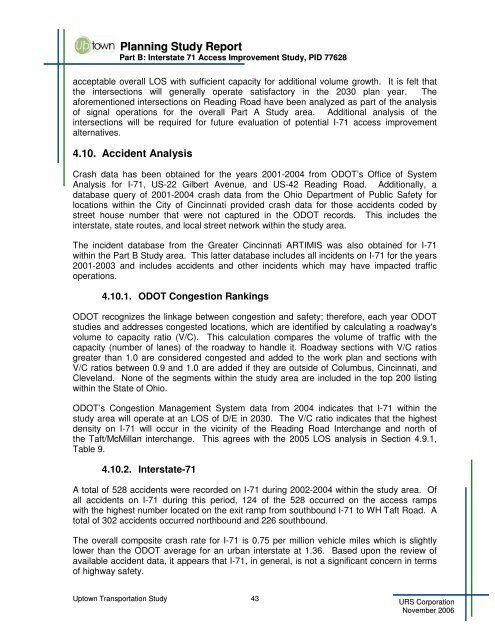Uptown Transportation Study - OKI
Uptown Transportation Study - OKI
Uptown Transportation Study - OKI
Create successful ePaper yourself
Turn your PDF publications into a flip-book with our unique Google optimized e-Paper software.
Planning <strong>Study</strong> ReportPart B: Interstate 71 Access Improvement <strong>Study</strong>, PID 77628acceptable overall LOS with sufficient capacity for additional volume growth. It is felt thatthe intersections will generally operate satisfactory in the 2030 plan year. Theaforementioned intersections on Reading Road have been analyzed as part of the analysisof signal operations for the overall Part A <strong>Study</strong> area. Additional analysis of theintersections will be required for future evaluation of potential I-71 access improvementalternatives.4.10. Accident AnalysisCrash data has been obtained for the years 2001-2004 from ODOT’s Office of SystemAnalysis for I-71, US-22 Gilbert Avenue, and US-42 Reading Road. Additionally, adatabase query of 2001-2004 crash data from the Ohio Department of Public Safety forlocations within the City of Cincinnati provided crash data for those accidents coded bystreet house number that were not captured in the ODOT records. This includes theinterstate, state routes, and local street network within the study area.The incident database from the Greater Cincinnati ARTIMIS was also obtained for I-71within the Part B <strong>Study</strong> area. This latter database includes all incidents on I-71 for the years2001-2003 and includes accidents and other incidents which may have impacted trafficoperations.4.10.1. ODOT Congestion RankingsODOT recognizes the linkage between congestion and safety; therefore, each year ODOTstudies and addresses congested locations, which are identified by calculating a roadway'svolume to capacity ratio (V/C). This calculation compares the volume of traffic with thecapacity (number of lanes) of the roadway to handle it. Roadway sections with V/C ratiosgreater than 1.0 are considered congested and added to the work plan and sections withV/C ratios between 0.9 and 1.0 are added if they are outside of Columbus, Cincinnati, andCleveland. None of the segments within the study area are included in the top 200 listingwithin the State of Ohio.ODOT’s Congestion Management System data from 2004 indicates that I-71 within thestudy area will operate at an LOS of D/E in 2030. The V/C ratio indicates that the highestdensity on I-71 will occur in the vicinity of the Reading Road Interchange and north ofthe Taft/McMillan interchange. This agrees with the 2005 LOS analysis in Section 4.9.1,Table 9.4.10.2. Interstate-71A total of 528 accidents were recorded on I-71 during 2002-2004 within the study area. Ofall accidents on I-71 during this period, 124 of the 528 occurred on the access rampswith the highest number located on the exit ramp from southbound I-71 to WH Taft Road. Atotal of 302 accidents occurred northbound and 226 southbound.The overall composite crash rate for I-71 is 0.75 per million vehicle miles which is slightlylower than the ODOT average for an urban interstate at 1.36. Based upon the review ofavailable accident data, it appears that I-71, in general, is not a significant concern in termsof highway safety.<strong>Uptown</strong> <strong>Transportation</strong> <strong>Study</strong> 43URS CorporationNovember 2006
















